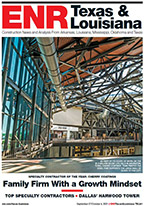TERRA Northwest (TNW) Phase 2 and 3, Northwest Arctic Alaska
Featuring 14 microwave towers, 22 modules and 22 fuel tanks across 450 miles of remote Arctic Alaska, the TERRA Northwest broadband system project was an immense logistical challenge for the team tasked with bringing a high-speed communication network to the area for the first time. The project also provided a link to Alaska's existing TERRA Southwest, the first segment of the network that was completed in 2011.
Engineers, construction firms, logistics companies as well as suppliers and vendors from across the state and Pacific Northwest came together for the project. It also involved federal, state, local and native landowners, each of which required different access and construction permits and logistics plans.
Project engineers sought to accommodate the area's unique environment and climate risks through design innovations. This included completely redesigning the foundation system of microwave towers to eliminate mass excavation work. The change, led by contractor STG, reduced the depth of excavation from more than 8 ft to about 3 ft.
"This was especially critical considering all equipment must be airlifted on site," says helicopter manufacturer-operator Erickson Inc. About 70 helicopter sling loads were required for each mountaintop site. STG and Erickson collaborated for months to develop a plan to fly towers in completed sections and stack them vertically in place at tower locations.
To support the large-scale operation in remote and austere terrain, Erickson provided aerial heavy-lift services to transport shelters, fuel tanks and battery banks, weighing between 11,300 and 19,000 lb.
Erickson says that use of the S64 Aircrane helicopter allowed the TERRA Northwest project to complete construction activities in days, an operation that would have typically taken weeks or even months using traditional land-based cranes.
The team also designed system components to not "stick out" more than necessary, says the project team. Engineers included secondary containments for fuel piping and designed communication modules to be used as bunk houses for technicians stranded in sudden bad weather.
Alaska's unpredictable and unforgiving weather presented a key safety risk—from blistering frostbite in winter to heat stroke in summer—with emergencies complicated by limited transportation options.
In summer 2013, field crews met every day with project managers before beginning communication tower installation around the city of Nome. They shared concerns and lessons learned from past work about safety risks ranging from firearms and camp housekeeping to weather and bear dangers. As a result, participants emphasized the strong project focus on incident prevention, with no lost-time accidents in 30,000 work hours.
The team also developed a proactive reporting system to identify potential problems and direct resources as required to address issues before they affected work. The effort prevented project participants from having to resort to crisis management mode.
Noting the project's remoteness and tough logistics, judges cited the team's innovative use of the air crane and a "good job of replicating lessons learned as they went along."
Key Players
Owner/Developer General Communications Inc./Unicorn
General Contractor/Lead Design Firm STG Inc.
Structural Engineer BBFM Engineers
Civil Engineer Recon LLC (Rowland Engineering Consultants)
MEP Engineer Great Northern Engineering (Electrical)
Geotechnical Engineer Golder Associates
Aerial Services-Heavy Lift Erickson Inc.
Module Design/Layout, Systems Development/Implementation Precision Power (Peak Oilfield Services)
Module Structural Design/Pre-Fabricated Building Trachte Inc.





Post a comment to this article
Report Abusive Comment